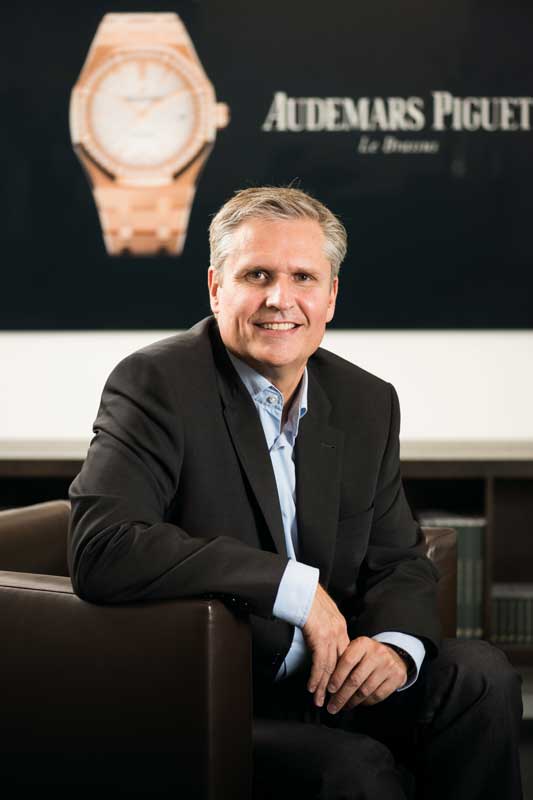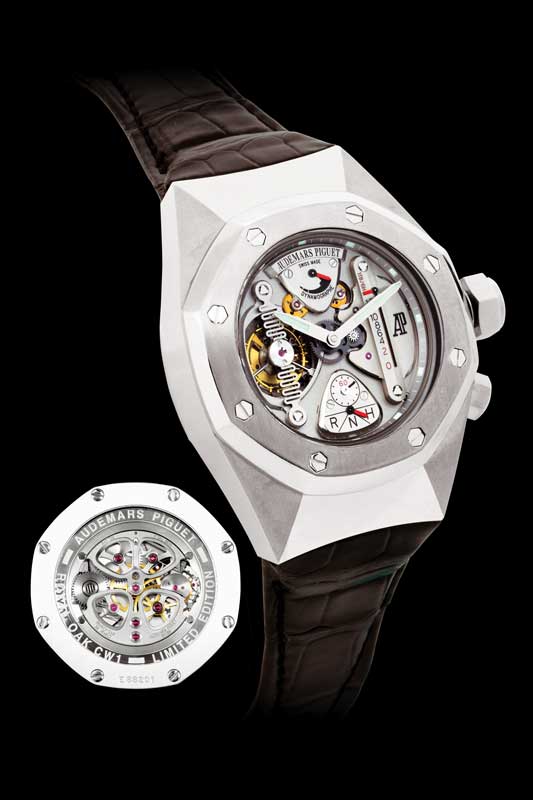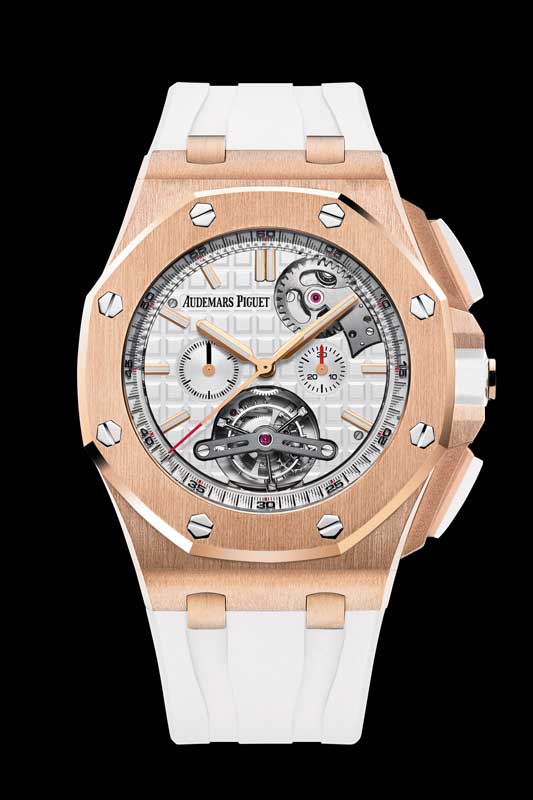Audemars Piguet
Maverick Concepts
Audemars Piguet
Maverick Concepts
You were formerly with Audemars Piguet, and now you’re back.Tell me why?
Audemars Piguet first approached me with an idea they wanted me to work on, and that’s how everything really started. I wasn’t exactly looking for a new challenge but the project went very well, even undergoing some drastic changes while we were doing it. So I came back.
Is the project in this year’s SIHH or is it for the future?
It’s in the pipeline.
Ah, something to look forward to then. I think one of your greatest achievements has been the Royal Oak Concept.
To call it traditional would be the wrong way to look at it — I saw the the emergence of new materials and new ideas, and thought, why not take all of that and make a watch out of it. We had a good discussion, had lots of drawings. It was truly an adventure which resulted in the product.
Giulio said that we would be making movements that were innovative, that brought something new to the table. And I had some ideas on how to bring these products to life. We met up every two weeks to exchange ideas, and it was a process that took two years. It evolved stage after stage, one idea led to the next, and culminated in the Concept.
I’d like to underline that when it comes to the Concept, it’s really a human adventure. The product is what it is, and it made such a landmark in Audemars Piguet’s history because it wasn’t an ego trip for anyone, it was borne of a relationship between Giulio and I, which grew and improved. It was something dense and intense. It was because we had a good flow of ideas, because we got along well together, that we were able to put something inplace, which has become an icon.
I was in the field of watches for 30 to 40 years already, and it was the first time that we were in a room where there was a constant exchange of ideas. There were some ideas that were deemed completely crazy or not implementable at that time. The whole process was quite rigid in the past, but what changed with the Concept then was that there were no boundaries. We rejected what was impossible, but there was no break in flow. That was really the first time that it had been this way. It was like going to see a good friend, and you’re going to have a good chat — it didn’t feel like work. And that’s why the result was so special.
When did you begin working at Audemars Piguet?
From 1999 until 2003. Once the Concept was done, once it was on the ground with its own life, it was like the end of a chapter. At that time, I wanted to get out again, and therefore I started my design company, and that’s how I found my path.

Creative Director of Audemars Piguet, Claude Emmenegger

The 1st Royal Oak Concept 2002
When the Royal Oak Offshore came out in 1994, it introduced a whole lot of concepts that were very new. For example, the size was bigger than what people expected in a men’s sports watch. So in many ways, you inherited the many new ideas that came with the breakthrough watch that was the Royal Oak Offshore. Can you tell me how that led to the creation of the Concept and how you took what the brand had already achieved, and brought it further?
The movement had to be of a memorable size, something a bit more robust than what it used to be. So between the Royal Oak and Offshore, the decision was pretty clear that we had to put it in an Offshore. We wanted to play with the angles, we had the bezels, we wanted to play with the shapes — in French you say ‘galbe’, meaning curves, and I wanted to introduce that into the Concept.
So that was the interesting part of the history. I had been working on the Royal Oak itself, playing with new ideas, new shapes, forms, and the curves as well. Then I realized that we couldn’t do what I wanted with the Royal Oak. Because it would have strayed too far from what used to be done, or what the Royal Oak was. That wouldn’t work. So we thought, let’s get something out there, play with it, if it works, it works, if it doesn’t, it doesn’t. It’s like when you are at the edge of the lake, you take a stone and you throw it in. Is it going to make a lot of waves or not? Does it sink and you only see one small ripple? It was the same approach.
There was no pressure at all, because at the beginning, it was just one piece, and the intention was to see how people would react. Nobody predicted [the attention it would receive] at that time. It was the landmark 30th year of the Royal Oak; we wanted to do something for the anniversary. And there was no constraint in terms of sales targets, or it would lead to a new collection or the number of pieces we had to sell
— there was none of that. Yet that first Concept has evolved further to having its own dedicated collection now. If you go to the Audemars Piguet website today, you would see that the Royal Oak Concept is a collection on its own.
It’s actually the same scenario as the original Royal Oak, actually even the Offshore, when the company didn’t know what would happen with a radical new product. But the Concept was different from those earlier ones.
We worked under the radar; it didn’t really involve a lot of people. Had there been too many people involved right at the beginning, there would have been many opposing views, people giving us all the reasons it’s not going to work and why we shouldn’t spend time doing it. So we played with the ideas, we made it evolve, and when we thought we were ready, we shared it with the rest. Thankfully, the final decision was made to realize it for production.
When parents have kids, they want their kids to obey them. I have two kids, and sometimes my son disobeys me and doesn’t do what I want him to do. When he does something nicely, somehow, I am proud and I’ll feel that [what he did] was a smart move. If we relate it back to the company, we were doing exactly the same. We were disobeying. If you get the quality-control department, the engineers and the after-sales department on board too early, they will tell you all the reasons why you can’t do it. By doing what was done, by bringing them onboard right at the very end, it was too late to change anything.
You are in charge of the development of new concepts and new functionalities at Audemars Piguet?
There are a lot of satellites in Audemars Piguet, where people explore different fields. It may be materials, complications, innovations — by putting those people together regularly, along with the design aspect, suddenly, you open up fresh possibilities for new ranges of productions, for new collections, for new ideas. I am quite lucky, for it is pretty organized in Audemars Piguet. And there’s a lot of expertise in different fields. I don’t necessarily have to think of which complications to place in the movements. My job is to think of ways to make it look interesting, desirable, and how we can fit it into what Audemars Piguet has done so far. The idea is not to turn the company upside down when it comes to design of course, but to innovate, improve and surprise.
I want to get a sense of your personal philosophy of your innovation in watchmaking. What is it that is unique and how does it differ from your contemporaries?
For watchmaking, I like new designs and ideas. I look at watches more like pieces of art than toys. They have to be refined and they need to make sense. I prefer nurturing curiosity through subtlety such as having hidden complications — details you may not necessarily notice at first glance, but that you will love when you know about them. I also like attributes that are less evident, more refined, and also respectful of what Audemars Piguet is famous for, which is both the high levels of finishing and the constant innovation.
Moving forward, we are going to be as technical as it has always been, but now to present a watch with two, three or four tourbillons, such unabashed acts have already been executed. Whether they’re good or not, it is not up to me to say! But, that is not the field for me. I would like to venture into things that are as inspiring, as tricky to be working on like, for example, the Concept Laptimer Michael Schumacher. The goal is to do things that have never been done before, which serve a purpose, are challenging, and also result in a useful, subtle and refined watch.
What is unique about your approach, I feel, besides the technical side, is that there’s the emotional content, which is important.
I look at things globally. I like to play with different fields that are not meant to be put together. If you look at a car, and you look at what you see from the outside, and then you open the hood and you look at the engine, why not take inspiration from its exterior and apply it inside, and vice versa? The idea is to mix things up. It will be like taking inspiration from what you normally see on the case, and bringing it onto the movement. Or what we have done so far on movements, why not use some of the skills we have there, to integrate them into the case?
It doesn’t really matter where you start, I Iook at things in their entirety. Sometimes, I start with the movement, sometimes I start from the outside. But there is no one field that takes priority over the rest.
You’re an artist!
Perhaps, deep inside I am an artist, but I’m also very aware that we need to sell products. When we design new products and we find inspiration for something new, you have to do it in such a way that you can sell it at the end of the day. I’m not courageous enough to be a full-time artist.

Royal Oak Offshore Tourbillon Chronograph
So between the Royal Oak and Offshore, the decision was pretty clear that we had to put it into the Offshore. We wanted to play with the angles, we had the bezels, we wanted to play with the shapes — in French you say ‘galbe’, meaning curves, and I wanted to introduce that into the Concept.










